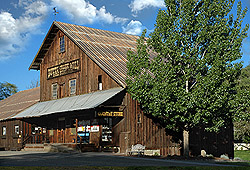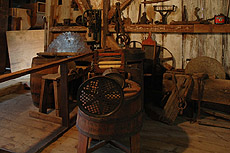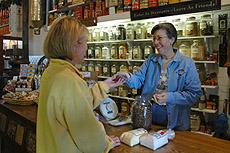|
Featured
Article
Butte Creek Mill
Historic Oregon Grist Mill
Experience History, Education and Cultural Celebration
A
National Treasure..
 A
Living Treasure stands rustically over Little Butte
Creek, water pouring out of her antique timbered side
like it has for far over a century. Her belts, pulley's
and stones have not stopped turning and telling the
story of the people who settled the Oregon territory.
It is not only a story of history but of the destiny
of those who would preserve the treasure from extinction
and share it with future generations. A
Living Treasure stands rustically over Little Butte
Creek, water pouring out of her antique timbered side
like it has for far over a century. Her belts, pulley's
and stones have not stopped turning and telling the
story of the people who settled the Oregon territory.
It is not only a story of history but of the destiny
of those who would preserve the treasure from extinction
and share it with future generations.
Over
130 years ago, a ship sailed majestically around the
horn to Crescent City carrying giant stones, quarried
in France for the purpose of grinding stone into flour.
The stones were carried over the mountains by wagon
to Snowy Butte Creek Mill. A waterwheel did not power
the mill but rather water flowed into a 12-foot deep
penstock, it's weight creating the pressure that activated
turbines powering the belts and pulleys that would move
the giant stones.
The
mill began operation in 1872. Farmers traveled from
miles away, their wagons filled with grain lining the
Old Military Road to Snowy Butte Creek Mill to have
their flour ground. The miller was paid for his services
by keeping every seventh bag of flour to sell in the
Butte Creek general store. The Klamath Indians trekked
90 miles from Fort Klamath to trade berries and leather
goods for flour.
History
Meets Destiny
 The
history of Butte Creek Mill met the Destiny of Bob and
Debbie Russell in 2005 when they purchased the old mill
and it was once again given the breath of life. It was
not the first time man's destiny would intervene to
preserve her. Peter Crandall, the mills previous owner
of 35 years, is credited with saving the mill, and upgrading
and maintaining its machinery so it continued as a working
thriving mill. The
history of Butte Creek Mill met the Destiny of Bob and
Debbie Russell in 2005 when they purchased the old mill
and it was once again given the breath of life. It was
not the first time man's destiny would intervene to
preserve her. Peter Crandall, the mills previous owner
of 35 years, is credited with saving the mill, and upgrading
and maintaining its machinery so it continued as a working
thriving mill.
Peter,
an avid history buff and serious collector of historic
artifacts, found his motivation to upgrade the mill
from his passion for history. A passion for history,
alive in Bob Russell would bring the two men together
seven years ago when Bob Russell made the trip from
Portland to view Peter's collection of general store
items at the mill. Bob and Peter were kindred spirits.
 Bob
had begun collecting pieces of American History since
he was only nine years old. The year was 1959 and Kennedy
and Nixon were running for President. Bob would begin
his collection of campaign buttons that would include
antique buttons from every Presidential campaign including
President's McKinney and President Lincoln. During the
1960's and 70's, many historic buildings in Portland
were torn down and Bob's collection grew as he saved
many historic treasures from being lost. Bob
had begun collecting pieces of American History since
he was only nine years old. The year was 1959 and Kennedy
and Nixon were running for President. Bob would begin
his collection of campaign buttons that would include
antique buttons from every Presidential campaign including
President's McKinney and President Lincoln. During the
1960's and 70's, many historic buildings in Portland
were torn down and Bob's collection grew as he saved
many historic treasures from being lost.
When
Peter decided to sell his General Store Collection in
2004, he naturally called Bob who came to Butte Creek
Mill to take a look. When he arrived he learned that
Peter was also selling the Mill and the torch would
soon be passed to the Russell's securing the future
of a National Historic site.
Center
for Education and Cultural Celebration
 With
growth of population in the Rogue Valley and it's status
as a destination for culinary tourism, Butte Creek Mill
is serving residents and visitors even more than natural
vitamin and mineral rich flours, grains and award winning
baking mixes. It serves as a center for education and
cultural celebration and it's full potential is being
realized. The Russell's have the skills to see the mill
into the 21st century. Having had a successful career
in sales and marketing at Proctor and Gamble and in
the Office supply business, Bob Russell brings years
of business experience to the mill. Debbie's gifts lie
in hospitality, product presentation and along with
Bob organization and execution of the vision they share
for the mill. This is a family affair with son Scott
working with them. They also have two grown daughters
who live in Portland. With
growth of population in the Rogue Valley and it's status
as a destination for culinary tourism, Butte Creek Mill
is serving residents and visitors even more than natural
vitamin and mineral rich flours, grains and award winning
baking mixes. It serves as a center for education and
cultural celebration and it's full potential is being
realized. The Russell's have the skills to see the mill
into the 21st century. Having had a successful career
in sales and marketing at Proctor and Gamble and in
the Office supply business, Bob Russell brings years
of business experience to the mill. Debbie's gifts lie
in hospitality, product presentation and along with
Bob organization and execution of the vision they share
for the mill. This is a family affair with son Scott
working with them. They also have two grown daughters
who live in Portland.
Hundreds
of Rogue Valley school children are coming through the
mill and learning not only about American history, and
the science and technology involved in the mill operation
but they also learn about nutrition and ecology. Students
discover that Butte Creek is one of the most important
tributaries for Salmon and Steelhead joining the Rogue
River. The water rights secured in the founding of the
mill in 1872 mill, insure that the creek is a habitat
for fish year round. The Russell's plan on building
a pathway along the creek from the nearby covered bridge
to the mill for visitors to view the 15-20 Salmon climbing
the fish ladder every half hour in the fall.
The
mill will also be a center for cultural celebration.
The Russell's cleared out the old meat locker, a giant
freezer built in 1931 to make room for the Gift Box
packaging area and the Old Cheese Factory Building has
become an Antique Store. A two-acre riverside area will
be an area for weddings, concerts, parties and events.
On the bottom level of the mill near the water holding
area, a warm and rustic room with a long wooden table
provides the perfect space for wine tasting, dinners
and business meetings and retreats.
Hundreds
of visitors tour the mill and take home the whole grain
goodness in Butte Creek Mill's products often after
trying them first at a local hotel such as Ashland Springs
Hotel who uses the products. Rogue Valley Hospital chooses
the whole grain goodness of the mill's baking products
to serve patients.  While
the grain ground at the mill feeds the bodies of those
who enjoy it's whole grain goodness, the mill herself
brings to life history, ecology and the art of living
to all who partake of her wonders. The water still flows
endlessly into Butte Creek from her proud slightly weathered
side and the hum of her stones and turbines timelessly
echo through her warm hand sewn timbers. While
the grain ground at the mill feeds the bodies of those
who enjoy it's whole grain goodness, the mill herself
brings to life history, ecology and the art of living
to all who partake of her wonders. The water still flows
endlessly into Butte Creek from her proud slightly weathered
side and the hum of her stones and turbines timelessly
echo through her warm hand sewn timbers.
©
Copyright 2006 Butte
Creek Mill. No unauthorized duplication without
written consent. Photos courtesy of Dasja
Dolan.
|


![]()





